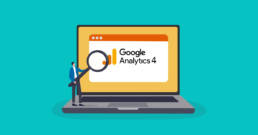
Getting to Know GA4: A Glossary of Terms

December 15, 2022
share this post
No doubt you’ve heard the news: Google Analytics 4 (GA4) is replacing all Universal Analytics (UA or GA3) properties, and by July 1, 2023, UA properties will no longer process new hits.
This doesn’t mean you need to up and abandon UA or GA3. After all, you likely have loads of meaningful data there. What it does mean, however, is that time is of the essence to start your migration to GA4—and to learn and explore what the new property offers.
If you’ve begun the process, you know that GA4 can feel like both familiar and foregin territory, with recognizable features and interfaces mixed in with totally new terms and capabilities. From “predictive metrics” to “consent mode” and “funnel analysis,” GA4 offers an abundance of new and improved analytical tools. But it takes time and patience, on top of skills and know-how, to set up and use effectively.
In our recent guide on GA4, we walked you through the benefits of upgrading and the steps involved in making the transition. Here, we break down 17 new GA4 terms you need to know as you learn the ropes of what Google calls the “next generation of analytics.”
active users
You may know the term “users” in UA, but take note that “users” in GA4 refers specifically to “active users” and not what UA referred to as “total users.” This term is tricky because we tend to think of active users as real-time users. In GA4, however, the active user metric is the number of distinct users who visited your website or app and had an “engaged session” (defined below).
anomaly detection alerts
Made possible by GA4’s machine learning and artificial intelligence capabilities, GA4’s anomaly detection does just as it sounds: detects and flags anomalies (or outliers) in your data. This means, for instance, that the surge of visitors triggered by your latest promotion or email campaign will not skew the data on overall site visits. Unlike GA3 or UA, GA4 uses historical data to identify and alert you of the outlier.
audience triggers
When users take part in a certain number of interactions on your site, audience triggers can activate events that encourage users to take additional steps. For example, you can create an audience trigger after users read a certain number of articles, visit a series of landing pages, or book a hotel for a particular event. The trigger can do practically anything: ask them to sign up for your newsletter, register for a webinar, book a consultation, or sign up for a membership.
bounce rate
Your bounce rate, in GA4, is the percentage of sessions that do not count as “engaged sessions” (defined below). This differs from the bounce rate in UA, which accounts for the percent of people who visit your site, without clicking to another page or engaging in any sort of interaction.
consent mode
Legislation and laws in many parts of the world require companies and organizations to acquire consent from a user before collecting data on that user. As people worldwide grow more concerned with how their data is used, “consent mode” in GA4 enables you to respect users’ privacy by allowing them to consent (or not consent) to collection. Interestingly, GA4 includes a feature called “behavioral modeling for consent mode” that uses machine learning and data from users who give consent to model behavior for those who do not consent. With this feature, you can gain insight on non-consented users, while respecting their privacy.
conversions
In UA, you measure conversions as “goals,” but in GA4, conversions count as “events.” Therefore, you would need to flag any events you want to count as a conversion. Those flagged events would then show up as conversions in your reporting.
cross-domain tracking
GA4 lets you track user behavior across multiple websites and apps through a process known as “cross-domain tracking.” With UA and GA3, cross-domain tracking was possible but not easy to configure. GA4 makes it far easier and even allows you to add as many as 50 properties (websites or apps) to a single account.
cross-platform analytics
With Google’s cloud data warehouse, BigQuery, you can run queries on large data sets and, if you use one, integrate GA4 with your customer relationship management (CRM) software like HubSpot, monday, or Salesforce. Google gives you up to 10 GB of storage, 1 TB of query processing, and 1 GB of BI Engine capacity (for Looker Studio Users) for free each month—an enormous perk that you will want to take advantage of and utilize.
data stream
In GA4, the term “data stream” simply refers to the flow of data from your websites or apps to your analytics account. You’ll have three types of data streams, including Web (for your websites), iOS (for iOS apps), and Android (for Android apps).
engaged session
A “session” in GA4 is triggered when a user opens your website or app or clicks on a page. An “engaged session,” then, refers to a session in which:
- a user views two or more pages
- one or more conversion events occur
- a user stays for more than 10 seconds
In GA4, you can manually change 10 seconds to, say, 40 seconds—or whatever length of time you think constitutes an engaged session.
engagement rate (vs. bounce rate)
GA4 offers a number of tools that let you monitor and then dig deep to investigate and refine your level of engagement with users. You can start with what GA4 refers to as the “engagement rate,” or the percentage of sessions that count as engaged sessions, meaning a user visits two or more pages, engages in one or more conversion events, or stays on your site for 10 seconds or longer (or whatever time parameter you designate). Bounce rate, on the other hand, refers to the percentage of sessions that were not engaged sessions. Ultimately, you want to work toward a high engagement rate and a low bounce rate.
event
An “event” in GA4 is like a “hit” in GA3, or any kind of interaction with your site or app, such as a page view or a click on a link, button, or video.
explorations
Through the Explore section of GA4, you can go beyond standard analytics reports to probe your data at a deeper, more nuanced level. For example, you can sort data with filters and segments, quickly perform ad hoc queries, and create custom reports on focused areas like Google Ads, keywords, social media traffic, and sales performance. Previously, only GA360 users who paid hefty licensing fees could “explore” data at this level. Now, however, anyone with GA4 can embark on any number of explorations—for free.
funnel analysis
When a user completes a desired sequence of steps on your site, such as filling out and submitting a form or registering and paying for an event, they are following steps referred to as a “funnel.” In GA4, you can set up and then track and analyze any number of funnels at no added cost, even specifying demographics like age, location, and gender. For instance, you can create a funnel for women between the ages of 20 and 25 who sign up for your free event, in response to a particular social media campaign. Ultimately, utilizing funnel analysis in GA4 can help you identify what works and what needs more refinement.
pageviews
Your pageview number may differ slightly in GA4 because GA4 does not distinguish between a page viewed on a webpage vs an app screen. It also includes repeat views of the same page. GA4 will no longer show unique page views. You will now find that in Acquisition > Audience report.
predictive metrics
GA4 uses machine learning to predict the future behavior of your users. Of course, you won’t be able to use predictive metrics immediately. It will take time—and data—to work effectively. What kind of predictions can you make? With GA4, you can find out the purchase probability, churn probability, and your predicted revenue. You can then use what you learn to tailor your marketing efforts and get the results you want.
session and session start
A “session” in GA4 starts each time a user opens your app or views a page or screen (and a session is not currently active). This action represents a “session start” event and involves the assignment of a session ID. Sessions time out (i.e., they end) after 30 minutes of inactivity, unlike in UA, where sessions start over at midnight.
Although these terms cover some of the basic (and game-changing) features of GA4, there is much more to the powerful, events-driven analytical platform. Our team at Astriata is excited about the transition and can help you optimize your websites and applications by taking advantage of what GA4 offers. Reach out to start the conversation.